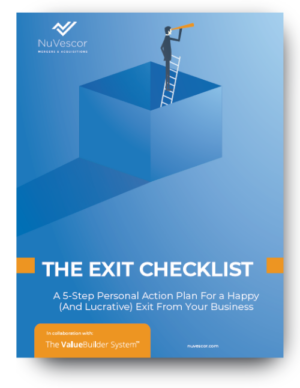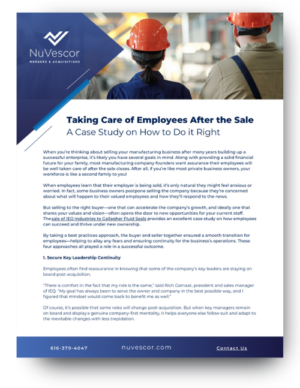
Create the Future You Want With Our Exit Checklist
Create the Future You Want With Our Exit Checklist
Peace of Mind
Is your business ready to sell? And: are you ready? At Nuvescor we understand that life’s big transitions may feel overwhelming. Getting ready to sell your manufacturing business qualifies as one of those milestones. However, once you’ve prepared for it by accessing our expert guidance you can feel confident that you’re making the right decision for your future, your family, and your employees— and that feels good.
Don’t miss out on our webinar and whitepaper
If you’re thinking about selling your business, you’ll need more than financial assessments and market analysis. This kind of decision demands clarity and planning to realize your goals for the future. That’s why we’re offering you our free on-demand webinar, “The Exit Roadmap: Your Five-Step Plan to a Successful Manufacturing Business Exit.” You can also download our accompanying whitepaper, “Personal Action Plan”. We’ll guide you through the essential steps you can take to help ensure that all goes well.
Five Easy Steps
Can you plan a successful exit strategy for your manufacturing business in just five steps? Our answer: a resounding yes. Our webinar and our whitepaper will get you up-to-speed on what you’ll need to do to create a successful exit strategy. Here’s a summary of tips and takeaways from our proprietary five-step checklist:
• Shape your strategy by gaining clarity on why you are considering exiting (for example: are you bored, is it time to retire, has the market peaked, do you want to do something else like travel or launch a new business?) In the process you can explore options including whether you want to sell outright, re-capitalize, liquidate, or transfer to your kids.
• Align your exit type with your why to enable a smooth transition. For example, if you are bored, or if you have a health issue, it may make the most sense to liquidate rather than transfer your business to family.
• Figure out your number to set a realistic and achievable financial target. Learn how to differentiate between what your business may be worth vs. what you may need or want for retirement or whatever goal you envision achieving next (consultant?) And know how to calculate the net proceeds.
• Visualize the life you want post-exit— an often overlooked but essential reality check. (Consultant? Traveling grandpa? Organic gardener? Motivational speaker? Pickleball pro?)
• Pinpoint your spot on our exit matrix; a key step in crafting the most effective exit strategy for you and yours. For example: Do you want to stay on during the transition?
You will also learn about current M&A trends in the manufacturing industry so you can better understand how today’s landscape may impact your exit strategy.
The Future is Here
Don’t miss this valuable opportunity to realize the future you want by creating a well-thought-out, solid exit strategy that prepares you to take the appropriate action.
You may have questions and we’re here to help you find just the right answers. To create your plan for a successful, rewarding exit from your manufacturing business, view our free on-demand webinar and download our whitepaper today.
Here’s to your bright tomorrows.










Recent Comments